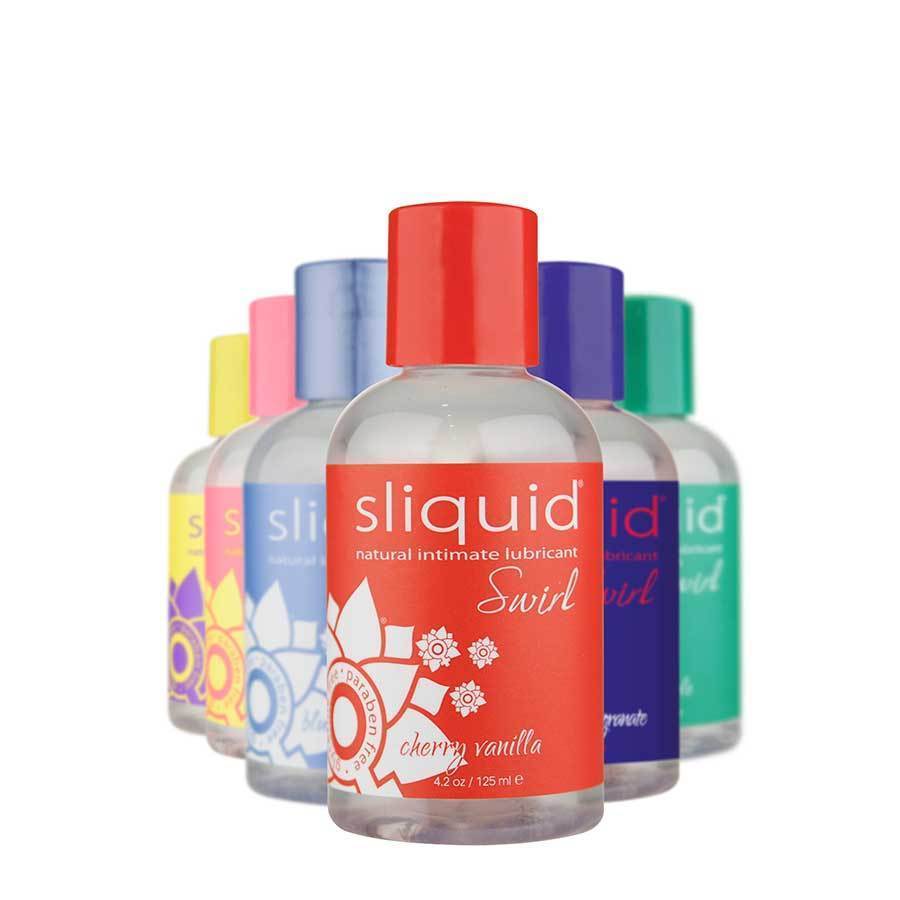Listen to an audio summary
Squirting. Gushing. Female ejaculation. Whatever you call it, it’s one of the most talked-about - and least understood - aspects of female pleasure. How common is it? Research says about 41.4% of adult women report squirting at least once in their lives. But depending on the study, that number ranges wildly — anywhere from 10% to 54%.
Here, we'll break down the stats, the science, and the experience behind squirting. Whether you're curious about what causes it, wondering why it hasn’t happened with your partner, or interested in how to explore it together, we’ve got you.
We’ll also get to the how-to tips too — for those who are interested.
At a Glance
-
Around 41% of women have squirted at least once — but estimates range from 10% to over 50% depending on the study.
-
Squirting isn’t the same as orgasm, and it’s totally normal whether it happens or not.
-
Most women who squirt do so 3–5 times in their lives; some much more, some just once.
-
Key factors include G-spot stimulation, clitoral play, and relaxation — plus open communication and comfort.
-
Men overwhelmingly enjoy it (90%+), but the real win is creating safe, pressure-free space to explore.
What Percentage of Women Squirt?
Here’s the headline stat: Around 41.4% of American women have squirted at least once, according to a study published in The Journal of Sexual Medicine. But don’t let that number fool you into thinking this is simple math. Depending on who you ask, the percentage ranges from as low as 10% to over 50%.
-
A 2013 review put it at 10–54%.
-
One of the largest self-reported surveys landed at 41.4%.
-
Another Swedish study puts the figure at 58%.
So, some source says 1 in 10 women - others say nearly 6 in 10. Look elsewhere online and you'll see smaller surveys that claim nearly 9 in 10 women squirt. That huge range highlights two things:
-
Female squirting is understudied, especially in medical contexts.
-
There’s still stigma and confusion around sex research, which can lead to under- or misreporting.
And just to be completely clear: squirting is not the same as orgasm. Some women squirt without climaxing. Some climax without squirting. Some do both, some neither — and all of that is normal.
What the Science (and Surveys) Actually Say
Although the science is somewhat limited, it's worth taking a look in more detail - as well as looking at surveys that collect anecdotal evidence from non-scientific sources.
How the Data Has Been Collected
Most studies on squirting rely on anonymous self-reported surveys, which is both a strength and a limitation. Some had age ranges as wide as 18 to 93. That wide net helps capture the diversity of experience, but it also means there’s room for misinterpretation and memory gaps.
A surprising trend? Many women discovered squirting around age 24, often by accident. This adds to the theory that squirting isn't something you’re simply “naturally able to do,” but rather something that can emerge through exploration and comfort.
Many women discovered squirting around age 24, often by accident
In truth, orgasm research has long been a focus of sexual science - but squirting gets far less attention - likely due to cultural taboos and lack of clinical interest.
Frequency & Experience Breakdown
Here’s how often women say it happens - according to the range of studies and surveys noted above:
-
28.9% have squirted 3–5 times in their life.
-
19.5% have squirted more than five times.
-
11.7% say it’s happened only once.
That paints a picture of variation, not rarity. Some experience it frequently, others once and never again.
Quick Stat List:
-
41.4% of women have squirted at least once
-
19.5% have squirted more than five times
-
28.9% have done so 3–5 times
-
11.7% just once
What Makes Squirting Happen?
Know we've got a little more insight into how often vaginal squirting happens, let's take a look at what makes it happen.
Squirting isn’t random — it’s often tied to a particular type of sexual pleasure, stimulation and environment (think: arousal, relaxation, bladder state, and more).
Types of Stimulation That Can Lead to Squirting
Here’s what the data shows about the kind of play that tends to lead to squirting:
-
Masturbation – 53.4%
-
Vaginal intercourse – 48.1%
-
Anal play – 19.4%
Now, all that said, plenty of women report more than one source, so there’s overlap.
A few things to keep in mind:
-
Deep internal stimulation (especially near the G-spot) is often involved.
-
Relaxation and feeling safe are crucial.
-
Communication helps — a lot.
How To: Techniques That Partners Have Reported As Helping
Curious to try? Here are some common techniques that partners say helped create the right conditions:
|
TECHNIQUE |
REPORTED SUCCESS |
| G-spot stimulation (come-hither motion) | High |
| Combining clitoral + internal play | High |
| Using firm, rhythmic pressure | Moderate to high |
| External anal stimulation | Variable |
| Switching angles during intercourse | Moderate |
| Open verbal feedback | Always helpful |
So, looking for a top tip based on this? Let her guide you. Check in. Watch for changes in breathing, moaning, muscle tension. If she says “don’t stop,” it's probably a good idea not to stop.
Do Women Enjoy Squirting?
In a word? Mostly, yes. But the emotional response is complex.
-
34% say it’s very pleasurable.
-
41.8% initially thought they were peeing — which can cause confusion or embarrassment.
-
Many feel more positive over time, especially when partners are supportive.
The bottom line is, a woman’s experience with squirting is influenced just as much by her mindset and environment as by technique.
So if you’re a guy reading this? Reassurance matters. If it happens, make her feel good about it. If it doesn’t, it's important not to make it a big deal.
What Do Men Think About Squirting?
Turns out, most men are pretty into it. In fact, the terms "squirt" or "squirting" regularly feature in the most popular categories on the main porn video-sharing sites.
-
Over 90% of male partners say they enjoy it — often for its visual intensity or sense of shared pleasure.
-
But not everyone loves the cleanup.
-
Some guys also worry about STIs or hygiene (valid points — pee and ejaculate are different, but good hygiene still matters).
Regardless of what anyone else thinks or enjoys - if you’re curious, great. Just don’t make it a mission. Curiosity is sexy. Pressure? Not so much.
Can Squirting Be “Taught”? A How-To for Men
There’s evidence that some women can learn to squirt with the right mix of mindset, communication, and physical technique.
Workshops and coaching groups have seen success rates of 50–70%, but it’s important to remember:
-
It’s not guaranteed.
-
Forcing it can backfire.
-
Some women simply won’t — and that’s okay.
If your partner is curious, the best thing you can offer is patience, presence, and a little know-how.
Making Your Partner Squirt — Step-by-Step
Here’s a basic approach to exploring squirting, respectfully and effectively.
Remember, this isn't prescriptive - so there's every possibility you won't be able to just work through these steps and get the outcome you're both looking for. Instead, think of each of these steps as different tools in your toolkit - you'll probably have to play around together and experiment to see what works.
Step 1. Start with foreplay
Foreplay isn’t just a warm-up — it’s a type of sexual stimulation that's essential for arousal, trust, and getting your partner into a relaxed, receptive headspace. Take your time exploring what she enjoys. Kissing, touching, dirty talk, or teasing can all help ease tension and build that slow, electric anticipation.
Step 2. Empty the bladder
Many women report that squirting feels like they’re about to pee — which can be a mental block. Going to the bathroom beforehand relieves pressure (literally and mentally), making it easier to let go during play. It’s a small step that can make a big difference.
Step 3. Use lube generously
More vaginal lubrication means more comfort, more glide, and way better sensations — especially when you’re doing internal stimulation. Don’t skimp. A high-quality water-based or hybrid lube is your best friend here. Bonus: it also reduces any friction that might make things feel too intense.
Step 4. Locate the G-spot
It’s about 1 to 2 inches inside, along the front (belly-button side) wall of the vagina. It often feels a little bumpier or firmer than surrounding tissue. Use your fingers to explore gently — every body is different, and for some women, the spot becomes more noticeable with arousal.
Step 5. Use rhythmic pressure
The classic “come-hither” motion with one or two fingers is a go-to for a reason. Steady, firm-but-gentle movements are usually more effective than fast or chaotic ones. Stay in sync with her breathing and reactions, adjusting your pace as needed.
Step 6. Add clitoral stimulation
For many women, clitoral play is what tips things over the edge. Use your fingers, tongue, or a small vibe — whatever she responds to best. Combining clitoral stimulation with G-spot pressure often creates the kind of deep, blended arousal that makes squirting more likely.

Step 7. Watch her cues
Pay close attention to her body language — deep moans, changes in breathing, muscle contractions, or hips pushing toward you. These signs tell you you’re on the right track. Always check in verbally too, especially if things start feeling intense or unfamiliar.
Step 8. Encourage release
That "I think I have to pee" feeling? It’s super common right before squirting — and it’s usually not pee. Reassure her that it’s totally normal and okay to let go. Being relaxed and uninhibited is key to allowing the body to do what it’s capable of.
Step 9. Catch or let flow
Whether you’re going full waterproof sheets or just letting it happen, it’s helpful to plan for some wetness. Having a towel, blanket, or waterproof pad can ease any cleanup stress and let both of you stay present in the moment.
Step 10. Debrief
Aftercare matters. Talk about how it felt, laugh if things got messy, and check in emotionally. Whether she squirted or not, celebrating the connection and curiosity you shared helps build trust — and sets the stage for even better experiences next time.
Remember, this isn’t a goal — it’s an adventure.
Summary
Squirting can be an amazing, intense, and connecting part of people's sex lives — but it’s not a measure of success.
Around 41% of women have experienced it, many more are curious, and some never will.
Whether your partner has squirted before or not, the real magic lies in exploration, consent, and communication. Focus on the journey, not the finish line — and you might just discover more than you expected.




